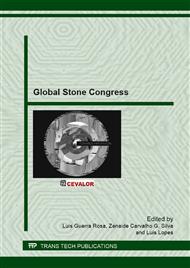p.275
p.287
p.295
p.304
p.317
p.329
p.336
p.348
p.363
Comparison between Methods of Biological Crust Removal on Granite
Abstract:
This paper presents the evaluation of the efficacy of the removal of biological crust from ornamental granites. The removal was made applying different procedures and the efficiency was evaluated by means of optic and scanning electron microscopy (SEM), Fourier Transformed Infrared spectrometry (FTIR) and colour measures (CIE-L*a*b* colour spaces). Among the cleaning procedures, an abrasive cleaning method, several chemicals-based methods applied by brush in aqueous media (using acids, bleach, benzalkonium chloride, ethanol and others) and laser (Nd:YVO4 at 355 nm) were used. This last method was previously found very efficient in removing graffiti and biological crusts in other granites. The present study was conducted on a granite of great commercial value from Galicia (NW Spain) and traditionally used on construction of historical buildings in this region and abroad. Slabs of this granite with an intense biological crust were used. Before the cleaning procedures, the biological crust was characterized by the same techniques to establish the comparison between Pre and Post cleaning. The efficacy in the crust removal was evaluated with optic and electronic microscopy; the best cleaning methods were the acid-based methods and laser. In both cases, no biological remains were found on the cleaning surfaces. Hydrogommage (the abrasive cleaning method) obtained intermediate results, and benzalkonium chloride cleaning showed the worst effectiveness. FTIR technique helped to identify the presence of organic signals of biological crust; and also, it provided useful information on the contaminant remains on the stone after cleaning and on mineral damages. Colour differences after cleaning gave additional information about the efficiency of the cleaning.
Info:
Periodical:
Pages:
317-325
Citation:
Online since:
April 2013
Keywords:
Price:
Сopyright:
© 2013 Trans Tech Publications Ltd. All Rights Reserved
Share:
Citation:



